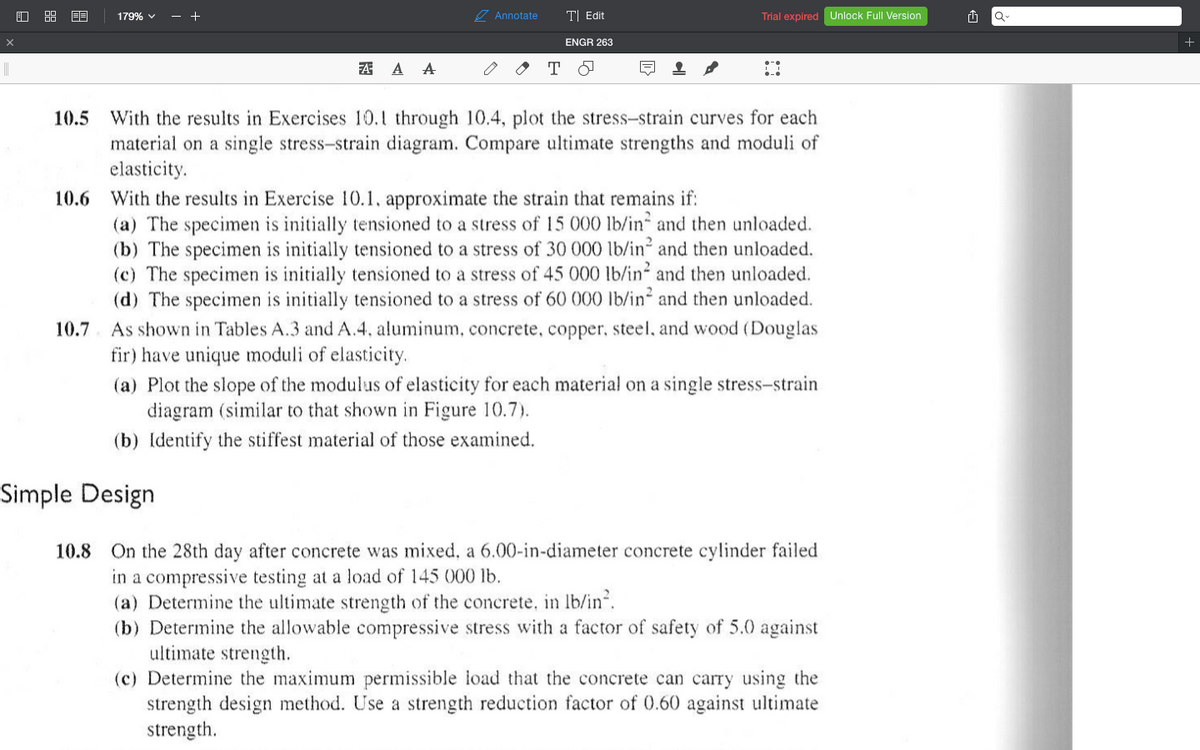n the 28th day after concrete was mixed, a 6.00-in-diame a compressive testing at a load of 145 000 lb. ) Determine the ultimate strength of the concrete, in lb/i ) Determine the allowable compressive stress with a fa ultimate strength. ) Determine the maximum permissible load that the ce
n the 28th day after concrete was mixed, a 6.00-in-diame a compressive testing at a load of 145 000 lb. ) Determine the ultimate strength of the concrete, in lb/i ) Determine the allowable compressive stress with a fa ultimate strength. ) Determine the maximum permissible load that the ce
Steel Design (Activate Learning with these NEW titles from Engineering!)
6th Edition
ISBN:9781337094740
Author:Segui, William T.
Publisher:Segui, William T.
Chapter1: Introduction
Section: Chapter Questions
Problem 1.5.6P: The data in Table 1.5.3 were obtained from a tensile test of a metal specimen with a rectangular...
Related questions
Question
Question 10.8 please

Transcribed Image Text:179% v
- +
7 Annotate
T| Edit
Trial expired Unlock Full Version
Q-
ENGR 263
A A A
오
With the results in Exercises 10.1 through 10.4, plot the stress-strain curves for each
material on a single stress-strain diagram. Compare ultimate strengths and moduli of
elasticity.
10.6 With the results in Exercise 10.1, approximate the strain that remains if:
(a) The specimen is initially tensioned to a stress of 15 000 lb/in and then unloaded.
(b) The specimen is initially tensioned to a stress of 30 000 lb/in and then unloaded.
(c) The specimen is initially tensioned to a stress of 45 000 lb/in and then unloaded.
(d) The specimen is initially tensioned to a stress of 60 000 lb/in and then unloaded.
10.5
10.7. As shown in Tables A.3 and A.4, aluminum, concrete, copper, steel, and wood (Douglas
fir) have unique moduli of elasticity.
(a) Plot the slope of the modulus of elasticity for each material on a single stress-strain
diagram (similar to that shown in Figure 10.7).
(b) Identify the stiffest material of those examined.
Simple Design
10.8 On the 28th day after concrete was mixed, a 6.00-in-diameter concrete cylinder failed
in a compressive testing at a load of 145 000 lb.
(a) Determine the ultimate strength of the concrete, in lb/in.
(b) Determine the allowable compressive stress with a factor of safety of 5.0 against
ultimate strength.
(c) Determine the maximum permissible load that the concrete can carry using the
strength design method. Use a strength reduction factor of 0.60 against ultimate
strength.
Expert Solution
This question has been solved!
Explore an expertly crafted, step-by-step solution for a thorough understanding of key concepts.
Step by step
Solved in 2 steps with 2 images

Knowledge Booster
Learn more about
Need a deep-dive on the concept behind this application? Look no further. Learn more about this topic, civil-engineering and related others by exploring similar questions and additional content below.Recommended textbooks for you

Steel Design (Activate Learning with these NEW ti…
Civil Engineering
ISBN:
9781337094740
Author:
Segui, William T.
Publisher:
Cengage Learning

Steel Design (Activate Learning with these NEW ti…
Civil Engineering
ISBN:
9781337094740
Author:
Segui, William T.
Publisher:
Cengage Learning